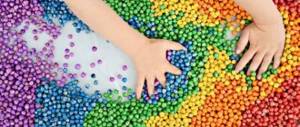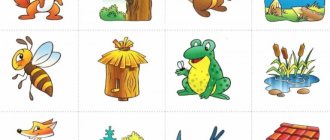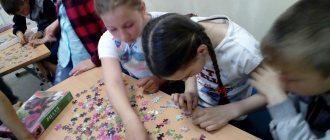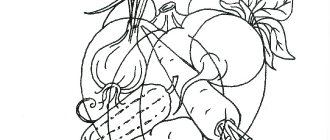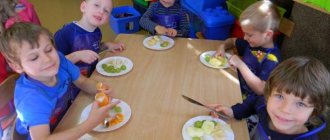Card index of didactic games for the development of sensory concepts and color perception in children
Progress of the game:
children are offered silhouettes of colors with primary (red, yellow, blue) and composite (orange, green, purple, blue) colors. There are several options for the game.
Option 1. The presenter adds two paints of primary colors and invites the participants in the game to determine the composite color that will be obtained.
Option 2. The presenter chooses one of the composite colors of paint and asks the participants in the game to find those paints (primary colors, when mixed, the color he has chosen is obtained.
Option 3. The participants of the game independently determine which primary colors of paints need to be added to obtain composite colors.
Didactic game
"Tasty palette"
Goal: expansion of the associative color range, expansion of vocabulary.
Name the picture and find its color on the palette. Select all the pairs: lemon - lemon... (etc.). Now try to guess what other colors can be called.
Find the carrot in the picture and the matching color on the palette. What is the name of this color? (Orange.) But you can say it differently - carrot.
Show beet color on your palette. Olive. Lilac. If it’s difficult, compare with images of fruits and flowers.
What would you call the color of plum? (Purple or plum)
How is yellow different from lemon? (Lemon is a shade of yellow with a slight hint of green.) Other colors are also considered.
Didactic game
"Color Nuances"
Sometimes artists paint copies of their paintings, which completely repeat the original (the first, main work) or have some differences. Compare these still lifes and find 5 differences. At first glance, they seem the same. Look closely at the coloring of both paintings, compare all the objects in pairs. And then try to draw your own still life from life. Take a vase or jug. Place it on the table. Place large, bright fruits nearby. Stand back and admire. If necessary, move the objects of the still life in search of the most interesting composition. And start drawing, checking with nature. Be more attentive to color.
Didactic game
"Choose by color"
Tasks:1. Develop the ability to distinguish and name primary colors (red, yellow, green, blue, orange, brown, gray, white, black); consolidate knowledge about colors such as purple, pink, orange.
2. Develop motor skills of the fingers through actions with objects;
3. Learn to group objects according to a certain criterion;
4. Develop perseverance.
5. Speech development.
Attributes: Sheets of cardboard (colored paper, cards with images of flowers, fruits, vegetables, animals, etc.
Description: The child is asked to arrange the presented cards according to color, name the depicted object and its color. The game can be played individually or in group sessions.
Such different objects. Game "Find by touch"
⇐ PreviousPage 27 of 46Next ⇒Types of children's activities: gaming, communicative, cognitive-research, motor, perception of fiction and folklore.
Goals: to teach to listen and observe carefully, to develop the ability for dialogical speech; learn to answer questions in words and sentences consisting of 3-4 words, enrich and activate vocabulary on the topic; teach children to distinguish and name geometric shapes familiar to them - a ball, a cube, a brick - in a variety of settings: upon presentation (what is this?);
among several others, different in name and color;
according to the teacher's word (find the cube).
Target guidelines for preschool education: can, following the verbal instructions of an adult, find objects by name (details of building material), takes part in examining building materials, in the game “Find by touch”, “Wonderful bag”, answers questions, listens with interest to the teacher’s story about features of a brick, cube and ball; masters the basic movements when performing the exercise “All day - knock and knock...”.
Materials and equipment: ball, cube, brick.
For the game: a set of pebbles, acorns, pieces of wood, pieces of fabric and fur, cotton wool.
Contents of organized children's activities
Organizing time.
Teacher (asks children)
.
Guys, do you want to be builders today? (Children answer.)
Main part. Consideration of building materials.
Teacher (shows and asks everyone to take turns naming a cube, a ball, a brick).
The brick is longer, you can put two cubes on it
(show)
.
And the cube is tall, like a small house. The cube is a house, and the brick is the path to the house. What cube? What does the cube look like? (The cube is tall, looks like a house.)
What brick?
What does a brick look like? (The brick is long. It looks like a path to a house.)
The teacher lays out bricks, balls, and cubes on his table. Invites everyone to take one item. The children return to their chairs and show each other what they have taken. The teacher asks who took what. Checks whether children correctly match the object with its name. Then he invites everyone who has cubes (bricks) to lift them up. If the child makes a mistake, reminds him: “A cube is like a house, a brick is like a path to a house.”
Then the teacher puts a hoop on the table and invites the children who took the balls to roll them into the hoop.
At the end of this work, the teacher collects the figures and places them on the rug in front of the children. Invites the children to take one brick from the mat. Checks how they completed the task. Offers to show the bricks to each other and name their color.
Then the teacher offers to take one cube at a time. The task is checked in the same way as the previous one.
Educator. Children have cubes, bricks, balls. The cube is tall. It looks like a house. The brick is long. The brick is like a path to a house. The ball is round and can be rolled.
The teacher reads a poem, the children imitate the movements (finger play).
| All day long - knock and knock, a ringing knock is heard. | Hands clenched into fists, thumbs up. With the right thumb (right hand on top) we hit the thumb of the left hand. |
| The hammers are knocking, we are building a house for the baby squirrels. | Throughout the entire poem, “the hammer hammers in the nails” - the thumb moves from top to bottom, the finger of the other hand gradually bends. |
| This house is for squirrels, This house is for bunnies, This house is for girls, This house is for boys. | Now they do the same with the resulting fist of the left hand, hitting the right thumb. |
| This is such a good house, We will live happily in it. We will sing songs, have fun and dance. | Children show “finished houses” - they stretch their hands clenched into fists forward. |
Games.
Game "Find by touch".
Purpose: to train children in distinguishing between hard and soft textures; activate the words hard, soft, soft
; teach children to find soft and hard objects according to a model, the teacher’s word, by touch.
Children are sitting at tables. In front of them are trays with a set of small objects (pebbles, acorns, pieces of wood, pieces of fabric and fur, cotton wool).
Teacher (takes a pebble from his set).
What is this?
(Pebble.)
What pebble?
(Hard.)
Can I crush a pebble?
(It cannot be crushed.) (The teacher invites everyone to find a hard pebble, touch it, then take a piece of cotton wool.)
What is this?
(Cotton wool.) (Asks the children to take a piece of cotton wool from the trays.)
What kind of cotton wool?
(Soft and white.) (The teacher shows the children a piece of fur, asks them to find pieces of fur in their sets, offers to wrinkle the fur.)
What kind of fur?
(Soft.)
Next, children are offered tasks of a different order: take a soft or hard object from the tray.
Game "Wonderful bag".
The teacher takes out a bag. It contains soft and hard objects. Now children determine by touch whether an object is soft or hard. The exercise is repeated several times.
Reflection.
The lesson ends with children playing with shapes. On the advice of the teacher, the children build a path to the house, roll balls into gates, and build turrets from cubes.
Lesson 4
Theatrical performance of L. N. Tolstoy’s tale “The Three Bears”. Let's decorate the plate
Types of children's activities: gaming, communicative, cognitive-research, visual, perception of fiction and folklore.
Goals: to help remember the content of the fairy tale, encourage the desire to participate in the dramatization of the fairy tale, develop memory; consolidate the ability to work with paints, learn to apply bright strokes and spots on paper, develop color perception, consolidate knowledge of color; teach to listen to music and react emotionally to it, to sing along with the teacher.
Target guidelines for preschool education: shows emotional responsiveness to L. N. Tolstoy’s fairy tale “The Three Bears”, activity in the performance of the song “Sleep, My Bear” (music by E. Tilicheeva, lyrics by Yu. Ostrovsky)
, takes an active part in productive activities (drawing patterns on a plate).
Musical accompaniment: “Sleep, my bear” (music by E. Tilicheeva, lyrics by Yu. Ostrovsky).
Materials and equipment: illustrations for a fairy tale, plates with a pattern (leaves, flowers, peas), sheets of white paper in the form of a circle, brushes, paints, napkins according to the number of children, a glass of water, toys - bears of different sizes, an easel.
Contents of organized children's activities
Organizing time.
On the table there are decorations for a theatrical performance of the fairy tale “The Three Bears” and figures of the characters from the performance are placed.
Educator. Today we will remember the fairy tale that I read to you earlier. Look at the heroes of this fairy tale and tell me what it is called. (Children's answers.)
Of course, this is a tale of three bears. Let's tell it together.
⇐ Previous27Next ⇒
Didactic game “Guess by touch”
Olesya Mashalanchuk
Didactic game “Guess by touch”
A didactic game is a multifaceted, complex pedagogical phenomenon: it is a gaming method of teaching preschool children, a form of education, an independent gaming activity, and a means of comprehensive education of a child’s personality. With the help of didactic games, sensory education of children is carried out, cognitive processes develop (curiosity, understanding of the relationship between simple phenomena)
.
The game is used as a means of developing thinking, speech, imagination, memory, expanding and consolidating ideas about the world around us. The main element of a didactic game is a didactic task hidden in a game form. Play is irreplaceable as a means of developing correct relationships between children.
The purpose of this manual: to enhance the cognitive development of children.
Objectives: Development of fine motor skills of the hands
Develop coordination of movements of the right and left hands
Learn to recognize an object by its characteristic features by touch
Development of children's spoken language
Didactic game “Wonderful Box”
First option.
Task: Find out an object using one of the analyzers.
Game action: Search by touch for a hidden object.
Rules: You cannot look into the box. First you need to determine what is in your hand, and then name the object to everything else.
Equipment. For the first games, vegetables and fruits are selected that are sharply different in shape and details, and even more similar, in a box.
Progress of the game. The teacher places vegetables and fruits in a box and asks to observe what the child will do. Then he asks one of the children: “Find what you want touch Now tell me what you took.” Or you can ask: “Find what I say (name)
" Children take turns completing the task.
Note. Subsequently, when the game is repeated, the box is filled in advance. Children should not see what is hidden there.
Second option
Task: Recognize an object by touch using the listed characteristics.
Progress of the game. The teacher lists signs that can be perceived by touch : shape, its details, surface, plane - and asks: “Find in the box something that looks like a ball, but with a long tail, hard, not smooth.” According to the description, the child searches for and finds beets.
First, vegetables and fruits that differ sharply in shape are placed in the box. When repeating the game, you can select objects that are similar in shape, but differ in other characteristics.
Didactic game "Matryoshka"
Task: Determine the size of familiar toys by touch .
How to play: The player has a disassembled matryoshka doll in the box. You need to set the matryoshka according to height.
I offer a didactic the guess by touch series (designed by teacher: Olesya Viktorovna Mashalanchuk, made by parents: Svetlana Borisovna Skobelev and Alexander Sergeevich)
Task: Search for hidden objects by touch , classify objects.
Rules: You cannot look into the bags. First, determine what is in your hand, and then name and show the object to everyone else.
Progress of the game: The teacher first places various objects in bags (natural material, geometric shapes, small animal toys, etc. The child guesses the object and puts it in boxes.
Didactic games are an indispensable means of teaching children. These games contain great opportunities and educational effects on preschool children.
